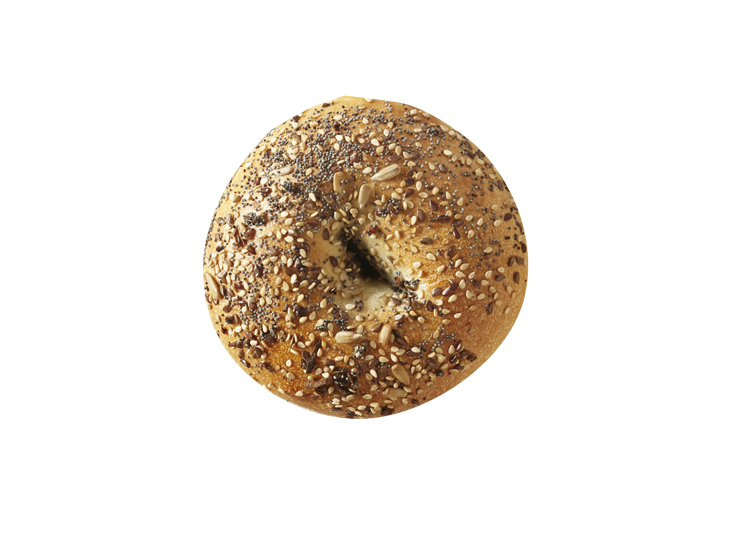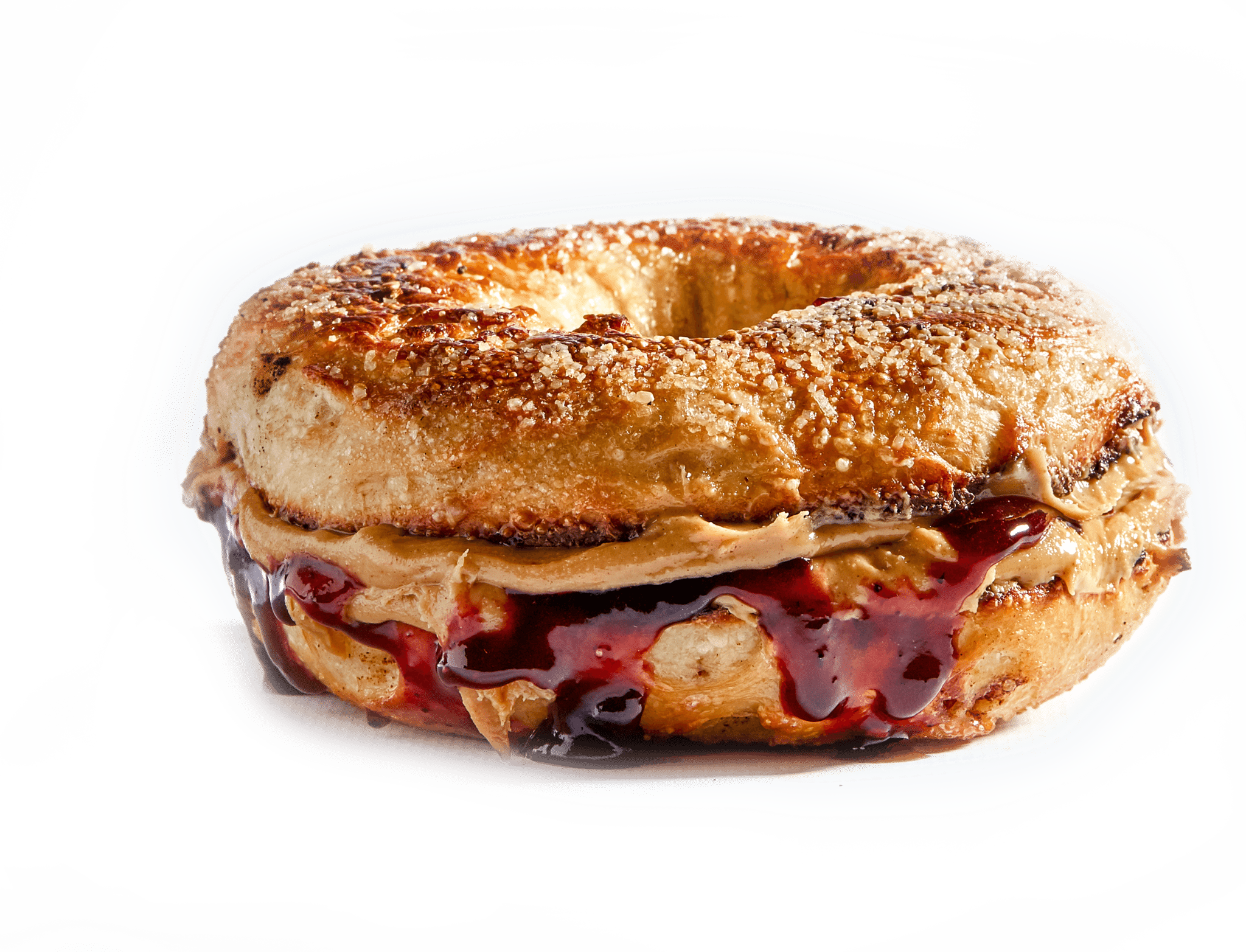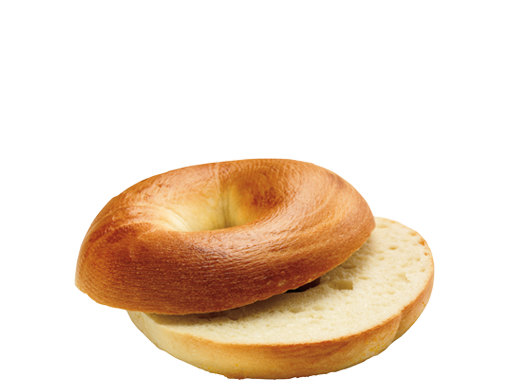Download top and best high-quality free Bagel PNG Transparent Images backgrounds available in various sizes. To view the full PNG size resolution click on any of the below image thumbnail.
License Info: Creative Commons 4.0 BY-NC
The bagel and the historical spelling beigel are bread product originating from the Jewish communities in Poland. It is traditionally formed by hand into a ring of about the size of hand-sized wheat dough with yeast, which is first boiled shortly in water and then baked. The result is a dense, chewy, doughy interior with a brown and sometimes crisp appearance. Bagels are often garnished with seeds baked on the outer crust, the traditional ones being poppy and sesame seeds. Some can be sprinkled with salt, and there are different types of dough, for example, wholemeal and rye. Bagels are eaten fried or unfried.
Although bagel’s origins are a little unclear, it is known that Ashkenazi Jews widely consumed them in the 17th century. The first known mention of the bagel in 1610 was in the Jewish community’s statutes in Kraków, Poland.
Bagels are now a famous bread in North America and Poland, especially in cities with large Jewish populations, many of which have alternative methods of making them. Like other baked goods, pretzels (fresh or frozen, often with various flavors) are available in many of the major supermarkets in these cities.
The basic design of the perforated roll is hundreds of years old and has other practical advantages besides providing more even cooking and baking of the dough: the hole can be used to pass threads or dowels through the bagels groups, which makes handling and transport easier and more attractive for the seller display.
Linguist Leo Rosten wrote in The Joy of Yiddish about the first known mention of the Polish word bajgiel, derived from the Yiddish word for a bagel, in the “Community Regulations” of Kraków in 1610, which states that food was given to women at birth.
In the 16th and first half of the 17th century, bagel became one of the staples of Polish cuisine and mainly of the Slavic diet. Its name comes from the Yiddish word beygal from the German dialect word beugel, which means “ring” or “bracelet”.
Variants of the word beugal are used in Yiddish and Austrian German to refer to a similar form of confectionery (Mohnbeugel (with poppy seeds) and Nussbeugel (with ground nuts) or in South German dialects (where beuge refers to a pile, e.g., holzbeuge “woodpile”. According to the Merriam-Webster dictionary, a “bagel” occurs from the transliteration of Yiddish “beygl”, which comes from Middle High German “böugel” or ring, which itself comes from “bouc” (round) in Ancient Greek-German, similar to Old English bēag “ring” and būgan “to bend, bow”. Likewise, another etymology in Webster’s New World College Dictionary says that the Middle High German form was derived from the Austrian German Begel, such as a croissant, and is similar to a German bugel, stirrup or ring.
Download Bagel PNG images transparent gallery.
- Bagel PNG HD Image
Resolution: 699 × 585
Size: 202 KB
Image Format: .png
Download
- Bagel PNG High Quality Image
Resolution: 750 × 550
Size: 237 KB
Image Format: .png
Download
- Bagel PNG Image File
Resolution: 694 × 463
Size: 528 KB
Image Format: .png
Download
- Bagel PNG Image HD
Resolution: 1000 × 800
Size: 448 KB
Image Format: .png
Download
- Bagel PNG Image
Resolution: 978 × 939
Size: 460 KB
Image Format: .png
Download
- Bagel PNG Images
Resolution: 600 × 600
Size: 360 KB
Image Format: .png
Download
- Bagel PNG Photo
Resolution: 2048 × 1565
Size: 889 KB
Image Format: .png
Download
- Bagel PNG Pic
Resolution: 620 × 474
Size: 100 KB
Image Format: .png
Download
- Bagel PNG Picture
Resolution: 909 × 932
Size: 577 KB
Image Format: .png
Download
- Bagel PNG Transparent HD Photo
Resolution: 1000 × 801
Size: 479 KB
Image Format: .png
Download
- Bagel PNG
Resolution: 2048 × 1565
Size: 845 KB
Image Format: .png
Download
- Bagel Transparent
Resolution: 2679 × 2689
Size: 9420 KB
Image Format: .png
Download
- Bagel
Resolution: 971 × 940
Size: 725 KB
Image Format: .png
Download
- Bagel Bread PNG Clipart
Resolution: 2862 × 1886
Size: 6020 KB
Image Format: .png
Download
- Bagel Bread PNG Free Download
Resolution: 600 × 416
Size: 411 KB
Image Format: .png
Download
- Bagel Bread PNG Image
Resolution: 800 × 764
Size: 820 KB
Image Format: .png
Download
- Bagel Bread PNG
Resolution: 1024 × 1024
Size: 534 KB
Image Format: .png
Download
- Bagel Bread Transparent
Resolution: 900 × 900
Size: 173 KB
Image Format: .png
Download
- Bagel Bread
Resolution: 1200 × 1200
Size: 629 KB
Image Format: .png
Download
- Bagel PNG Clipart
Resolution: 2572 × 2708
Size: 7875 KB
Image Format: .png
Download
- Bagel PNG Download Image
Resolution: 530 × 385
Size: 130 KB
Image Format: .png
Download
- Bagel PNG File Download Free
Resolution: 2950 × 2550
Size: 8906 KB
Image Format: .png
Download
- Bagel PNG File
Resolution: 3032 × 2276
Size: 8976 KB
Image Format: .png
Download
- Bagel PNG Free Download
Resolution: 500 × 350
Size: 74 KB
Image Format: .png
Download
- Bagel PNG Free Image
Resolution: 1475 × 1475
Size: 2848 KB
Image Format: .png
Download
























